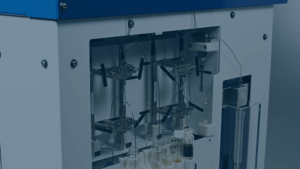Research by Interface Fluidics into enhanced oil recovery (EOR) provides a way to comprehensively analyze thief zones and now this work has been published in the journal ‘Fuel’. Interface’s microfluidic technology not only provides more and better data about EOR but can also provide cost savings and lead to cleaner operations.
Polymer flooding has been in use for decades and involves the injection of polymer-augmented water into oil fields to increase oil recovery. This process can improve the production from reservoirs with a wide range of rock heterogeneities, particularly those having thief zones.
So, what are thief zones, and how can nanotechnology help us to design a better process to mitigate the effects?
The problem
Thief zones are commonly present in oil reservoirs that impose operational risk for EOR processes – Specifically, during water flood operations, these high permeability zones offer a path of least resistance to water – leading to a reduction in oil recovered from the rest of the reservoir.
In contrast, polymer flooding helps solve this problem by increasing the viscosity of the injection water and improving the fluid mobility, which ultimately results in enhancement of flood conformance and higher oil recovery. However, this process is complex and difficult to predict.
While core and sand pack models can address this problem, these methods cannot isolate thief zone impact or accurately control initial conditions. They also fail to provide timely results as they are complex requiring large sample volumes.
The microfluidic solution
The team at Interface Fluidics saw this as both a problem and an opportunity to implement a more innovative method.
Interface uses a client’s reservoir information – like pore throat size distribution, permeability, porosity, and wettability – to create a silicon-glass microchip that represents the client’s reservoir. The analogue results are highly repeatable and offer a way to isolate and compare performance of different fluids at varying conditions. Additionally, high-resolution optical imaging gives visual access to capture fluid dynamics occurring in the process.
Interface’s plan for improving EOR
For this research, the Interface team designed an analogue with four connected reservoir zones with large permeability and porosity differences. Secondary water flood and tertiary polymer flood were studied to quantify the pore-scale recovery and evaluate the impacts of thief zones on process efficiency.
Sodium Chloride brine with 50,000 ppm salinity and the West Texas oil with 135 cP were used as connate water and reservoir oil, respectively. 5,000 ppm Calcium Chloride brine was utilized to conduct secondary water flood as well as synthesizing a 30 cP polymer solution using hydrolyzed polyacrylamide (HPAM).
The microfluidic analogue contained four distinct but connected zones. The zones’ permeabilities decreased from the top (zone k1) to the bottom (zone k4). Permeability differences were achieved by varying each zone’s pore depth and porosity.
First, brine was injected followed by oil to establish initial water and oil saturations. Oil was injected at 15 ft/day for 20 minutes to ensure a constant saturation profile.
Once initial saturations were established in the analogue, the team connected the brine pump for the water flooding process. This involved brine injection at ~5 ft/day for five hours, followed by polymer injection at ~5 ft/day for two and a half hours.
As crude oil is naturally fluorescent, the Interface team took fluorescent images during brine and polymer injections.
Results of water flooding
The video shows the rapid brine fingering into the high permeability zones. The first thief zone formed when the brine reached the production side, also known as breakthrough. As a result, the amount of oil displaced was much higher for zones k1 and k2. Water displacement efficiency peaked at 46.1% for k1 and dropped to as low as 3.6% for k4.
Next, the Interface team initiated polymer flooding. Unlike water flooding, polymer flooding recovered oil from all four zones, primarily the lower permeability zones (zone k4), where the recovery factor reached ~60%.
A closer look
For water flooding, zones k1 and k2 were in communication while k2 and k3 began communication after the breakthrough – leading to a finger forming in k3, which quickly dissipated, resulting in minor oil production.
During polymer flooding, polymer flowed from k3 to k4, perpendicular to the original flow, leading to significant oil recovery. Researchers also recommend polymer flooding as a secondary method, preventing early breakthroughs and improving oil displacement.
During this research, polymer flooding resulted in oil extraction from untouched lower permeability zones, thief zone mitigation and interzonal fluid communication improvement. The efficacy of secondary polymer flooding was also verified. The main achievement of this work was establishing a microfluidic platform as a diagnostic tool for EOR allowing us to better understand flow behaviour and formulate chemistries.
Applying this technology for Interface clients
This novel research contribution has strong practical techno-economic implications. With Interface’s unique screening capability, energy companies can now make better informed decisions by replicating real reservoirs on analogues to visualize and analyze fluid behavior at the pore scale. This leads to better EOR polymer selection which leads to more oil extracted at a lower cost.
In recent years, the energy industry has made significant strides in sustainability – a necessary transformation despite oil prices reaching a seven-year peak in 2022. EOR processes are potentially positioned to assist in making oil extraction more efficient both environmentally and economically.
Supply chain constraints causing problems in recent months have also led those in the industry to require more agility in decision making and operation. Interface’s innovative technology allows for clients to make smarter, faster decisions – allowing for increased polymer flooding EOR yields, cost cutting and decreases in water consumption.
With the EOR market only expected to keep growing, let Interface Fluidics provide the information needed to get the most out of your reservoirs. To find out how we can assist with your organization’s efficient operations, contact us at .




